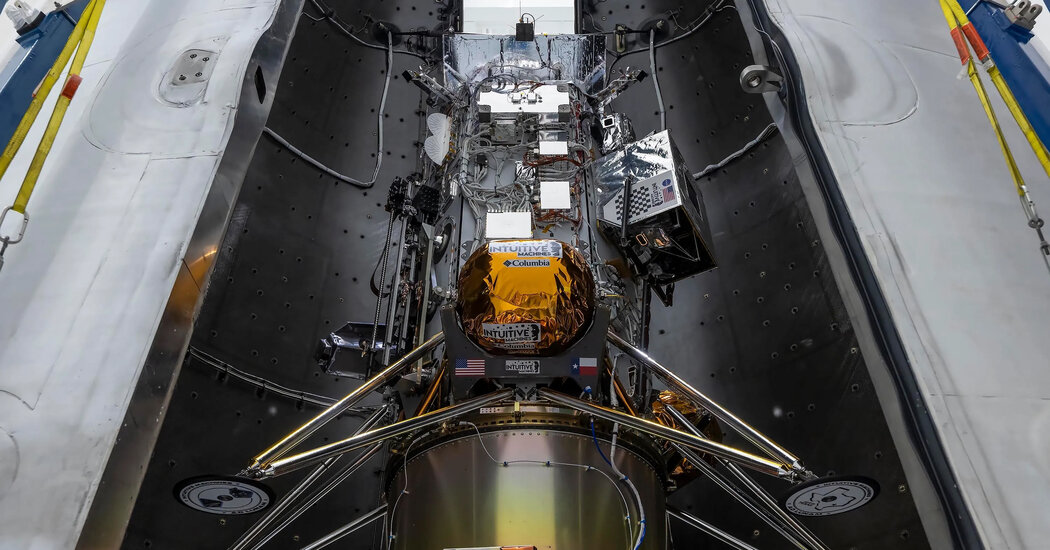Here is the plain text result:
Intuitive Machines landed a robot on the moon last year. Can the Houston company do it again, but keep the spacecraft upright this time?
When the spacecraft, named Odysseus, set down on the moon last February, it managed to communicate with Earth even though it had toppled on its side. It was the first commercially operated lander to reach the moon’s surface, and the first American vehicle to land softly on the moon since Apollo 17 in 1972.
The company’s second lander, named Athena, is now on the launchpad. Here’s what you need to know about Wednesday’s flight.
Athena and three other spacecraft will launch on top of a SpaceX Falcon 9 rocket from NASA’s Kennedy Space Center in Florida. Launch is scheduled for 7:16 p.m. Eastern time on Feb. 26. There is a greater than 95 percent chance of favorable weather.
If weather or technical issues arise, backup opportunities will be available during a four-day launch window. After that, the mission would have to be delayed by a month.
NASA will provide coverage of the launch beginning about 45 minutes before liftoff.
If the launch occurs Wednesday, the Intuitive Machines spacecraft will try to land on March 6 in Mons Mouton, a region about 100 miles from the moon’s south pole. That will be closer to the south pole than any previous lunar lander.
The main payload is a drill for NASA as part of its Commercial Lunar Payload Services program. Paying a commercial company like Intuitive Machines to take something to the moon is cheaper than having NASA design and build its own spacecraft.
The drill is designed to dig up soil up to about three feet below the surface. It will extract lunar soil about four inches at a time. An instrument known as a mass spectrometer will then sniff around the drilled material for compounds like frozen water that easily transform into gases.
The Athena lander is also carrying three robotic rovers and a small flying “hopper” that will be deployed after landing.
On the airless moon, helicopters cannot fly, but thrusters will allow the hopper to fly long distances. It will also be carrying one of the Nokia cellphone antennas. The plan is to fly into one of the moon’s permanently shadowed craters.
The mission on the surface is scheduled to last for less than one lunar day, or about 10 Earth days, until the sun sets. With no solar energy, the spacecraft’s batteries will run out of power.
But in the middle of the lunar day, on March 14 at about 2 a.m. Eastern time, darkness will fall for a few minutes — an eclipse when the Earth passes between the sun and the moon.
The solar-powered lander will have to draw power from its batteries during the eclipse but should survive.
The Odysseus lander was supposed to use a laser altimeter to guide it to the moon’s surface. But because of an oversight during the launch preparations, a safety switch for the device was never disabled, rendering that tool useless.
The Athena lander is almost identical to Odysseus — each is what the company calls its Nova-C design — and Intuitive Machines officials said they had tested the laser multiple times.
Three more separate spacecraft are riding on the Falcon 9 rocket. They are essentially taking advantage of extra payload space in the rocket for a cheaper ride to space.
One, Lunar Trailblazer, is a lost-cost NASA mission — about $100 million — designed to measure the distribution of water on the moon from orbit.
While Athena will make a quick one-week trip to the moon, Lunar Trailblazer will take a more leisurely, fuel-efficient path. If launch occurs on Wednesday, it will take just over four months to reach the moon. (If the launch occurs on a different day, the journey could be as long as seven months.)
A second spacecraft, Odin, is a microwave-size spacecraft built by the company AstroForge of California. It will head to a near-Earth asteroid to examine whether it might be full of valuable metals that could be mined in the future.
A third vehicle, CHIMERA GEO 1, is a spacecraft from Epic Aerospace of San Francisco designed to put small satellites in distant orbits.
What else is landing on the moon soon?
Athena is the third commercial lander launched toward the moon this year, although it might be the second to arrive.
On January 15, a Falcon 9 rocket launched carrying the other two landers — Blue Ghost from Firefly Aerospace of Austin, Texas, and Resilience by Ispace of Japan.
Blue Ghost, like Athena, is part of NASA’s CLPS program, and it is scheduled to land on March 2, ahead of Athena. It is headed toward Mare Crisium, a basin in the northeast quadrant of the near side of the moon.
Resilience, also known as the Hakuto-R Mission 2 lander, is taking an indirect route and is expected to arrive at the moon in May. Its landing site is near the center of Mare Frigoris, or the Sea of Cold, in the moon’s northern hemisphere. This will be Ispace’s second lunar landing attempt.
Source link




